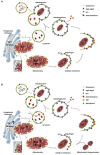Lysosomal and Mitochondrial Liaisons in Niemann-Pick Disease
- PMID: 29249985
- PMCID: PMC5714892
- DOI: 10.3389/fphys.2017.00982
Lysosomal and Mitochondrial Liaisons in Niemann-Pick Disease
Abstract
Lysosomal storage disorders (LSD) are characterized by the accumulation of diverse lipid species in lysosomes. Niemann-Pick type A/B (NPA/B) and type C diseases Niemann-Pick type C (NPC) are progressive LSD caused by loss of function of distinct lysosomal-residing proteins, acid sphingomyelinase and NPC1, respectively. While the primary cause of these diseases differs, both share common biochemical features, including the accumulation of sphingolipids and cholesterol, predominantly in endolysosomes. Besides these alterations in lysosomal homeostasis and function due to accumulation of specific lipid species, the lysosomal functional defects can have far-reaching consequences, disrupting intracellular trafficking of sterols, lipids and calcium through membrane contact sites (MCS) of apposed compartments. Although MCS between endoplasmic reticulum and mitochondria have been well studied and characterized in different contexts, emerging evidence indicates that lysosomes also exhibit close proximity with mitochondria, which translates in their mutual functional regulation. Indeed, as best illustrated in NPC disease, alterations in the lysosomal-mitochondrial liaisons underlie the secondary accumulation of specific lipids, such as cholesterol in mitochondria, resulting in mitochondrial dysfunction and defective antioxidant defense, which contribute to disease progression. Thus, a better understanding of the lysosomal and mitochondrial interactions and trafficking may identify novel targets for the treatment of Niemann-Pick disease.
Keywords: acid sphingomyelinase; cholesterol; intracellular trafficking; lysosomal disorders; lysosomes; mitochondria; sphingolipids.
Figures


Similar articles
-
Finding pathogenic commonalities between Niemann-Pick type C and other lysosomal storage disorders: Opportunities for shared therapeutic interventions.Biochim Biophys Acta Mol Basis Dis. 2020 Oct 1;1866(10):165875. doi: 10.1016/j.bbadis.2020.165875. Epub 2020 Jun 6. Biochim Biophys Acta Mol Basis Dis. 2020. PMID: 32522631 Review.
-
Mitochondrial Cholesterol in Alzheimer's Disease and Niemann-Pick Type C Disease.Front Neurol. 2019 Nov 7;10:1168. doi: 10.3389/fneur.2019.01168. eCollection 2019. Front Neurol. 2019. PMID: 31787922 Free PMC article. Review.
-
Niemann-Pick type C disease: The atypical sphingolipidosis.Adv Biol Regul. 2018 Dec;70:82-88. doi: 10.1016/j.jbior.2018.08.001. Epub 2018 Aug 28. Adv Biol Regul. 2018. PMID: 30205942 Free PMC article. Review.
-
Hydroxypropyl-beta and -gamma cyclodextrins rescue cholesterol accumulation in Niemann-Pick C1 mutant cell via lysosome-associated membrane protein 1.Cell Death Dis. 2018 Oct 3;9(10):1019. doi: 10.1038/s41419-018-1056-1. Cell Death Dis. 2018. PMID: 30282967 Free PMC article.
-
Niemann-Pick C variant detection by altered sphingolipid trafficking and correlation with mutations within a specific domain of NPC1.Am J Hum Genet. 2001 Jun;68(6):1361-72. doi: 10.1086/320599. Epub 2001 May 9. Am J Hum Genet. 2001. PMID: 11349231 Free PMC article.
Cited by
-
Perspectives on Organelle Interaction, Protein Dysregulation, and Cancer Disease.Front Cell Dev Biol. 2021 Feb 25;9:613336. doi: 10.3389/fcell.2021.613336. eCollection 2021. Front Cell Dev Biol. 2021. PMID: 33718356 Free PMC article. Review.
-
Heterocyclic sterol probes for live monitoring of sterol trafficking and lysosomal storage disorders.Sci Rep. 2018 Sep 26;8(1):14428. doi: 10.1038/s41598-018-32776-6. Sci Rep. 2018. PMID: 30258093 Free PMC article.
-
npc2-Deficient Zebrafish Reproduce Neurological and Inflammatory Symptoms of Niemann-Pick Type C Disease.Front Cell Neurosci. 2021 Apr 27;15:647860. doi: 10.3389/fncel.2021.647860. eCollection 2021. Front Cell Neurosci. 2021. PMID: 33986646 Free PMC article.
-
Lysosomal Stress Response (LSR): Physiological Importance and Pathological Relevance.J Neuroimmune Pharmacol. 2021 Jun;16(2):219-237. doi: 10.1007/s11481-021-09990-7. Epub 2021 Mar 22. J Neuroimmune Pharmacol. 2021. PMID: 33751445 Free PMC article. Review.
-
The Contribution of Lysosomes to DNA Replication.Cells. 2021 Apr 30;10(5):1068. doi: 10.3390/cells10051068. Cells. 2021. PMID: 33946407 Free PMC article. Review.

